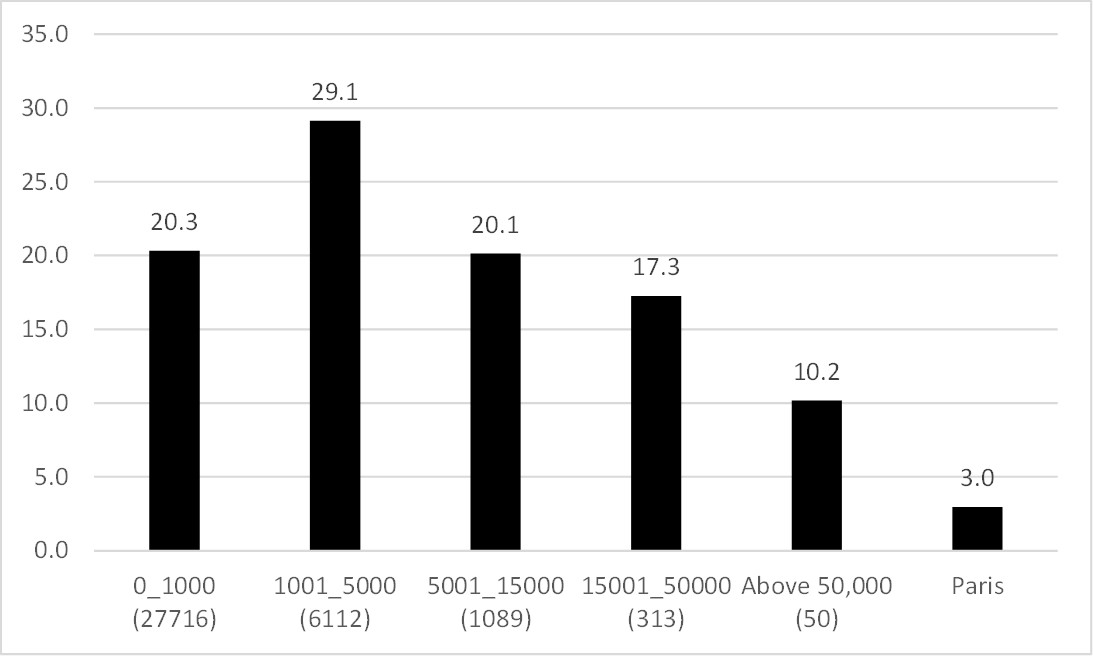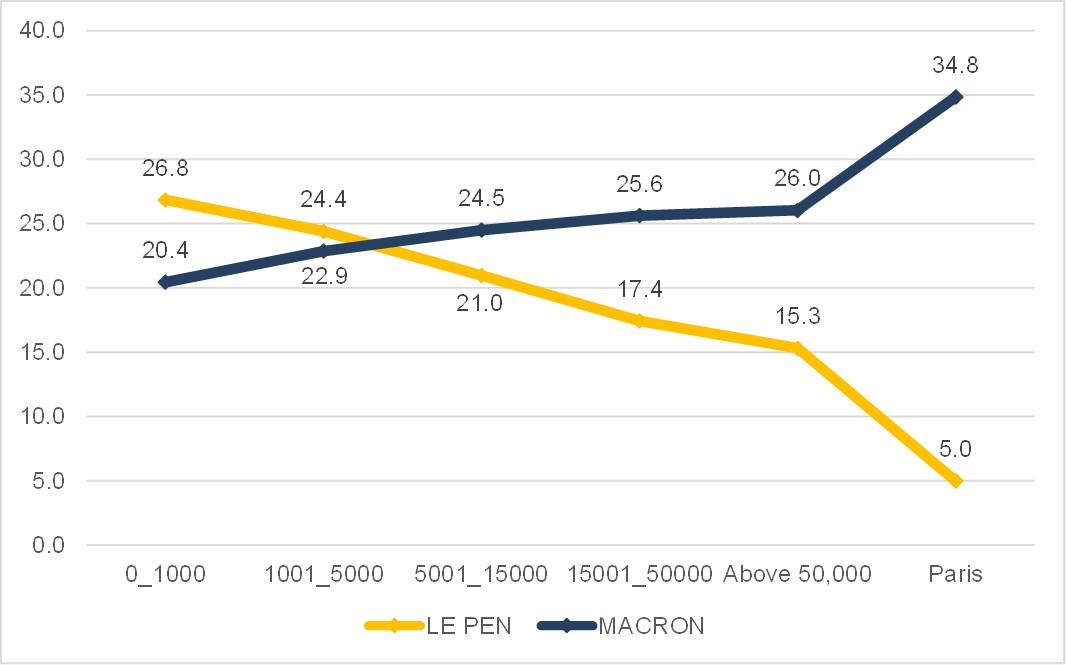(traduzione a cura di Elisabetta Mannoni)
Notwithstanding Macron’s victory, the result of the French Presidential election is the prove that an earthquake hit the political setting in France with the exclusion – for the very first time since 1958 – of both pillars of Fifth Republic, the socialist and the Gaullist parties.
The second round between Emmanuel Macron and Marine Le Pen perfectly represents the increased relevance of a new dimension of competition, different from the left-right one that had prevailed so far. A dimension which is orthogonal with respect to the left-right axis, and for which the scientific research has not found a shared definition yet. (https://georgetownvoice.com/) We’re talking of a conflict between the ‘open society’ and the ‘closed society’, where those in favor of globalization, multiculturalism and European integration fight those who stand for ‘demarcation’ (Kriesi et al. 2006), welfare chauvinism and the return to the nation-state. These are two sides of a conflict which involves (not always consistently, especially in the Southern Europe) cultural, economic, and institutional issues, and whose proud representatives are respectively Macron and Le Pen. Marine Le Pen launched a challenge to the French system and to the Gaullist right years ago; yet, these elections are still something new, since for the first time there is a political entrepreneur on the other side too, and he was able to politicize the conflict over Europe and globalization (instead of avoiding them, as the mainstream socialist parties would usually do), and to mobilize his electorate on these issues.
Yet, are we really faced with a new cleavage, as stated by part of the literature? Or is it just an old – apparently dormant – conflict which is being reactivated again?
My hypothesis – to be confirmed – is that at the basis of this hypothetical new cleavage there would be the reactivation of the old urban-rural cleavage. According to the original formulation by Lipset and Rokkan (1967), the urban-rural conflict was all about tariff barriers and commodity prices. The newborn class of industrial entrepreneurs would fight for the abolition of tariff barriers, the openness of the market and the consequential decrease in prices for raw materials. The declining class of the landowners was opposing to them, and wanted to maintain the tariff barriers to protect the national agricultural production. We already had, so to speak, a conflict between those in favor of globalization and those in favor of protectionism. Is it possible that this conflict has been somehow reactivated by new political entrepreneurs[1], who are trying to take advantage of the electoral opportunity that this conflict creates?
A first – definitely preliminary – test that can be performed to verify such hypothesis is about the analysis of the French vote by demographic size of towns. This latter is a variable that is usually neglected by scholars of elections and voting behavior, yet it has proven to be an important determinant, for instance, of the vote in Italy (Emanuele 2011; 2013).
From a comparative perspective, we can safely affirm that Italy is ‘a country of small villages’ (Emanuele 2011, 118), with just 23% of the population living in cities with more than 100,000 inhabitants; France, on the other hand, is the most rural European country. In fact, mainland France (l’‘Hexagone’) has 35.281 cities (in Italy these are around 8.000), almost the 80% of which having less than 1000 electors (and 12.5% with less than 100 electors). This is a legacy of the post-revolutionary organizational model, that can be noticed in Piedmont too, to some extent. The most incredible aspect, as the Figure 1 shows, is that almost 50% of electors live in villages with less than 5.000 electors, while just 13% of electors live in medium-big cities (that is, cities with more than 50.000 electors; in Italy this percentage rises to 35%). The city of Paris only represents 3% of the electorate.
Figure 1. Number of cities and percentage of the electorate by category of demographic size, France 2017.
These data give an idea of how salient the urban-rural dimension is in France, as well as of the potential differences (in socio-demographic, cultural, and political-ideological terms) between the electors living in the multitude of microvillages and those living in the Parisian metropolis. Since we do not have individual data to verify these differences, we can analyze at the aggregate level the vote for Macron and Le Pen for the six demographic categories that we saw in Figure 1 above (five categories plus Paris). The result, graphically represented in Figure 2, is remarkable and shows a first encouraging empirical evidence for our hypothesis. The two candidates show a specular profile for the demographic variable. The vote to Marine Le Pen is clearly rural-oriented. Her support is inversely proportional to the demographic size of towns: she is close to 27% in the small villages with less than 1000 voters, and her consensus gradually decrease to 15% in medium-big cities. In Paris it almost disappears around 5% (here she is fifth in voters’ preferences, after the socialist Hamon). On the opposite side, Macron’s profile reveals his prevalently urban character: Hollande’s ex Minister’s support tends to increase proportionally to the demographic size of towns, from 20% in microvillages (in those with less than 100 electors he gets 18.5%), to 35% in Paris.
Data shows the presence of two crucially different realities, coexisting within the same country: there is a swing of 18.1 points between Paris and the villages with less than 1000 electors. There are in fact 6.4 points of advantage for Le Pen in microvillages and almost 30 in favor of Macron in the capital.
Figure 2. Vote trends for Le Pen and Macron by demographic size of towns, French Presidential election 2017, first round.
We do not know, without a proper individual-level analysis, if these marked differences between city and countryside are just the consequence of other variables that are at stake or if they witness, instead, the reactivation of the old urban-rural cleavage on a new basis. What is for sure, is that such differences between city and countryside have been found in the analysis about Brexit vote too, where the ‘Remain’ won in London and in many other urban areas, and the ‘Brexit’ won in the rural England. In that case too, the referendum divided parties and the electorate clearly on a different conflict axis from the left-right one, with Conservatives and Labour taking different stands within their own parties, whereas UKIP on the one side, and LibDem and SNP on the other politicized the two sides of the conflict.
This is definitely a crucial issue to understand the XXI century politics, and it requires necessary and more in-depth analysis.
References
Dogan, M. (1967) ‘Political Cleavage and Social Stratification in France and Italy’, in S.M. Lipset and S. Rokkan (eds.) Party Systems and Voter Alignments: Cross-national perspectives, New York: The Free Press, pp. 129-95.
Emanuele V. (2011), ‘Riscoprire il territorio: dimensione demografica dei comuni e comportamento elettorale in Italia’, in Meridiana – Rivista di Storia e Scienze Sociali, 70, pp. 115-148.
Emanuele, V., (2013), ‘Il voto ai partiti nei comuni: La Lega è rintanata nei piccoli centri, nelle grandi città vince il Pd’ in De Sio, L., Cataldi, C. and De Lucia, F. (eds) (2013), Le Elezioni Politiche 2013, Dossier CISE(4), Rome, CISE, pp. 83-88.
Kriesi, H., Grande, E., Lachat, R., Dolezal, M., Bornschier, S., and Frey, T. (2006). Globalization and the transformation of the national political space: Six European countries compared. European Journal of Political Research, 45(6), 921-956.
Lipset, S.M. and Rokkan, S. (1967) ‘Cleavage structures, party systems and voter alignments: an introduction’ in S.M. Lipset and S. Rokkan (eds.) Party Systems and Voter Alignments: Cross-national perspectives, New York: The Free Press, pp. 1-64.
Rokkan, S. (1970) Citizens, Elections, Parties, Oslo: Universitetsforlaget.
Tarrow, S. (1971) ‘The urban-rural cleavage in political involvement: the case of France’, American Political Science Review, 65(2): 341-57.
[1] The rural parties that politicized the urban-rural cleavage have either disappeared or changed since the 50s. For the conditions to the rise of agricultural parties, see Rokkan (1970). For the reasons why this cleavage did not give rise to an agricultural party in France, see Tarrow (1971). For an analysis of the vote in the rural areas in France, see Dogan (1967).


